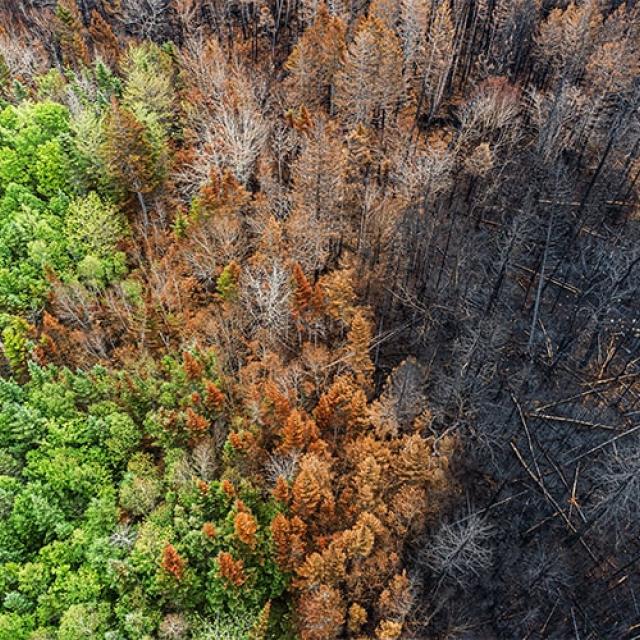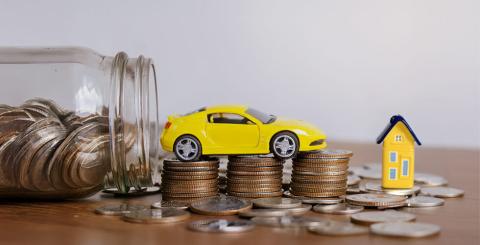Forest fires and insurance: What’s covered?

Over half of Québec, or more than 906,000 km2, is covered by forest. So it’s not surprising that according to Société de protection des forêts contre le feu (SOPFEU), Québec has an average of more than 400 forest fires a year. The situation is the same nationally.
With climate change leading to high temperatures and extreme drought conditions, fire is ravaging greater and greater expanses of land across Canada. in Québec, the 2023 wildfire season was the most devastating on record, with 4.5 million hectares burned in northern and intensive protection zones, an all-time record.
Given these statistics, you may want to check whether you're well protected in the event of this type of disaster. Read on to find out everything you need to know about forest fires to keep your family and property safe.
What are the main causes of forest fires?
According to the Government of Québec, 75% of forest fires in the southern half of the province are caused by humans. Recreational activities, such as camping, hunting and fishing, and associated equipment, are responsible for many fires each year, just like camp fires, burning garbage, arson, and smoking. Logging and industrial operations also pose wildfire risks, as does rail transport.
After human activities, lightning is the second leading cause of forest fires in Québec. Extreme heat, wind and dryness allow sparks from lightning to ignite and spread. In fact, just over half of the 713 fires recorded in Québec in 2023 were started by lightning.
How can we prevent forest fires?
To reduce the risk of forest fires, the Government of Québec has put preventive measures in place that can be applied when the fire danger level is high. For example, the government can suspend burning permits and cancel existing ones, prohibit open fires, and prohibit traffic and access to the forest.
In addition to government measures, we all have a role to play in forest fire prevention. The PareFEU fire prevention guide developed by the Ministère des Ressources naturelles et des Forêts and SOPFEU provides a series of tips for reducing the risks associated with forest fires. Here are some recommendations to adopt if…
you live in a high-risk area, in a primary or secondary residence:
- Find out whether you live in a high-risk area by checking the SOPFEU interactive map.
- Prior to building a camp fire or burning garbage, refer to the SOPFEU fire danger index and the restrictions in effect.
- Maintain your property by removing dead leaves and other flammable debris, including tree branches near your home and electrical wires.
- Store flammable products safely, away from the house.
- Dispose of hot ashes properly, such as in a designated storage container located a reasonable distance from the house and vegetation.
- Make sure your outdoor fireplace has a spark screen.
- Make your home more fire resistant, for example by switching to non-flammable or treated materials. It’s also important to install and maintain your stove and chimney according to the manufacturer’s standards and your municipality’s recommendations.
- Equip yourself to act quickly by preparing an emergency kit and family emergency plan.
you engage in recreational activities in the forest:
- Before building a camp fire, consult the SOPFEU fire danger index and the restrictions in effect.
- Follow the steps to safely build and put out a fire.
- Avoid smoking in the forest or near wooded areas, and don’t throw your butts out the window.
- Don’t use power tools that can create sparks during risk periods.
- Comply with any restrictions and prohibitions.
What to do in the event of a forest fire?
Are you in a danger area threatened by fire? Here are the steps you can take to act quickly and safely when a forest fire threatens:
- Keep all combustible materials away from the house. To prevent smoke from entering, close the windows, turn off any fans, and temporarily block vents with non-flammable materials.
- Park your car facing forwards so you can leave quickly. Make sure you have enough fuel and put an emergency kit in the trunk.
- If the authorities in the municipality where you live issue an evacuation order, you must leave the area. Quickly gather your essential and valuable personal belongings, as well as those of your children and animals. Do not return to the house if you’ve forgotten something.
- Before you get behind the wheel, check road conditions online at Québec 511 or by calling 511.
- While on the road, keep your car windows closed and circulate air exclusively inside the passenger compartment to avoid filling it with smoke.
- Tell your loved ones where you’re going.
- If you cannot evacuate, find a safe place to take shelter.
- Monitor the situation by listening to the radio and by checking the websites of the different levels of government, SOPFEU and your municipality.
- Wait for official permission before returning to the affected area.
Forest fire damage: is it covered?
Has a forest fire damaged your primary or secondary residence? Rest assured that if your property is covered by a home insurance policy, damage to buildings and your personal property caused directly by a forest fire or how it was put out is covered, according to the terms and limitations of your insurance policy. Contact your insurance company promptly to inform them of the situation. They will open a claim and assign it to a claims adjuster, who will check your coverage, explain the steps to follow, and guide you through the claims process.
Here are some examples of what is usually covered by your insurance and what you could claim in the event of fire damage following a forest fire:
- Damaged personal property
- Damage to the building
- Additional living expenses following an evacuation order issued by a civil authority
- Property that is temporarily away from the insured premises
- Property taken away from the insured premises as a precaution
- Fire department fees
- Outdoor vegetation (trees, shrubs, plants and lawns)
Important: Thinking about buying a home near a wooded area or on land at risk of forest fires? It’s essential to contact your damage insurance representative to find out what home insurance coverage is available to protect your new home in the event of a fire. You will then need to maintain the insurance amounts required to cover your building and property. Most importantly, don’t wait for the forest fire season to start to buy home insurance or update your insurance amounts, because by then, it may be too late.
Protecting your secondary residence from forest fires
Do you feel that the value of your secondary residence or cottage is not high enough to insure it? If you include all your furniture, the losses resulting from a major disaster like a forest fire could be higher than you think. You should also be aware that in addition to covering your buildings and personal property, your home insurance includes liability insurance that covers you for bodily injury or property damage you may cause unintentionally, for example if a visitor injures themselves at your cottage or a campfire gets out of control and damages a nearby property.
Bundle your insurance and save!
At Promutuel Insurance, we offer you a discount on your premium when you combine your home and secondary residence insurance with us. Insure your secondary residence by contacting one of our damage insurance representatives and enjoy your little piece of paradise worry free!



